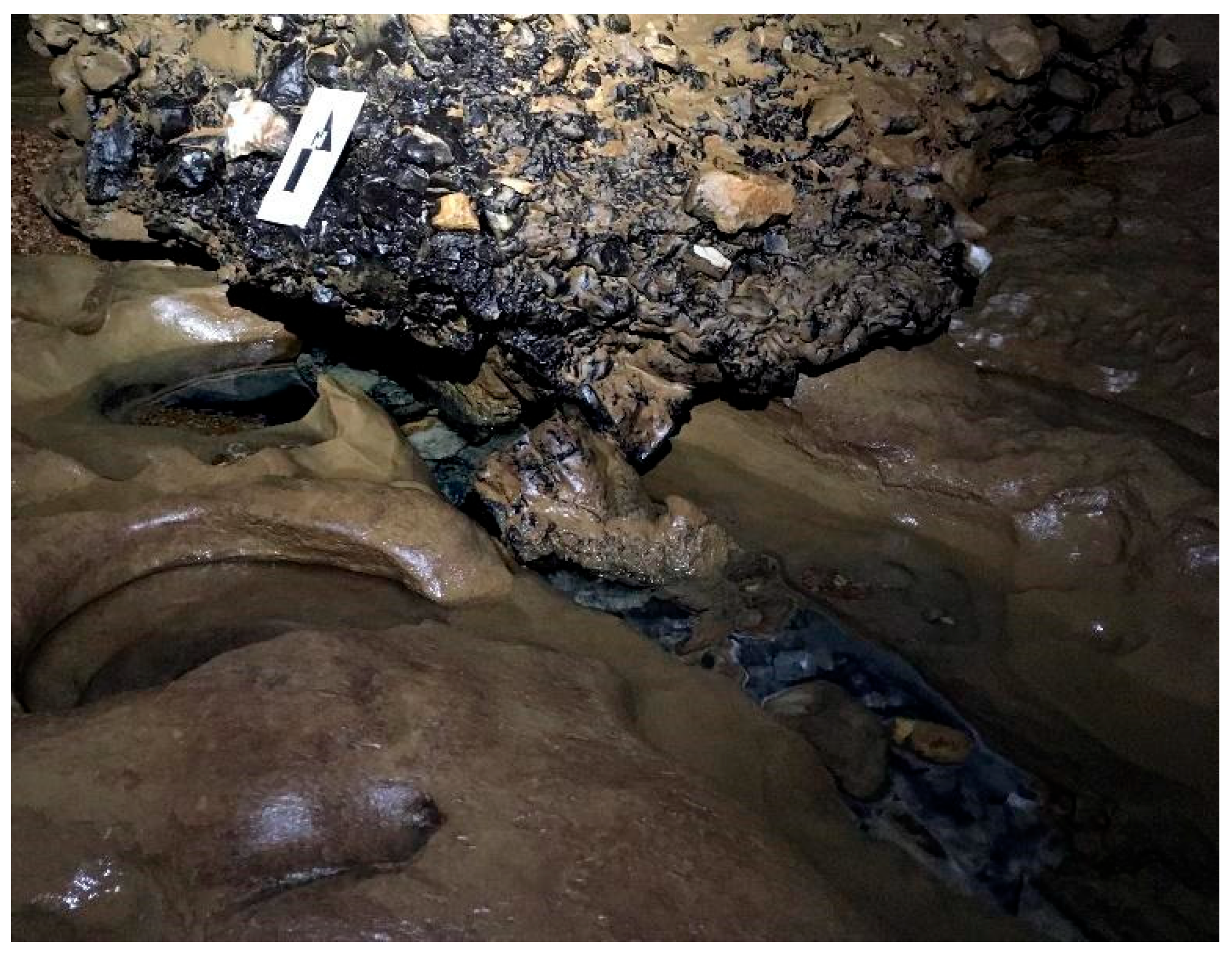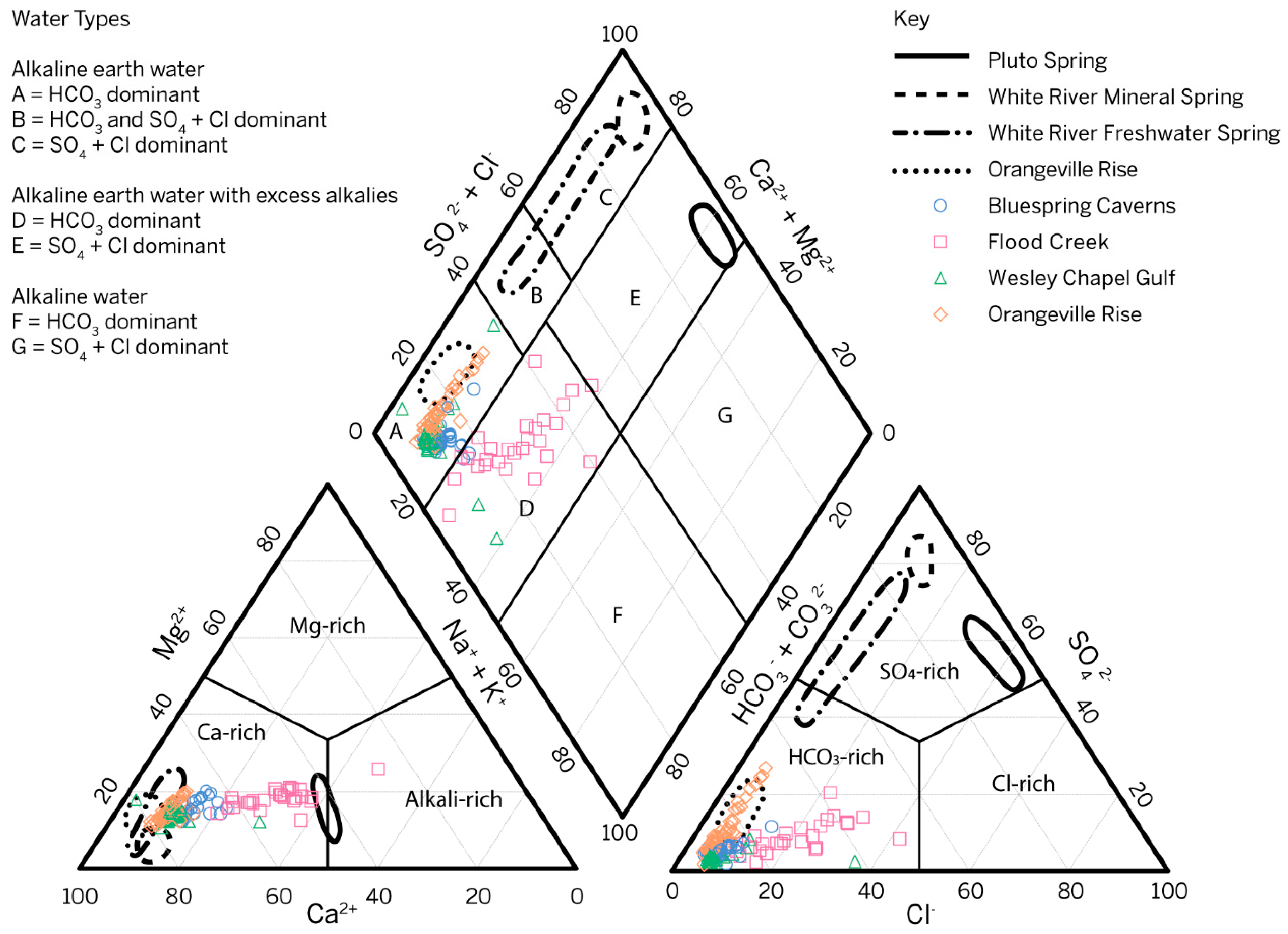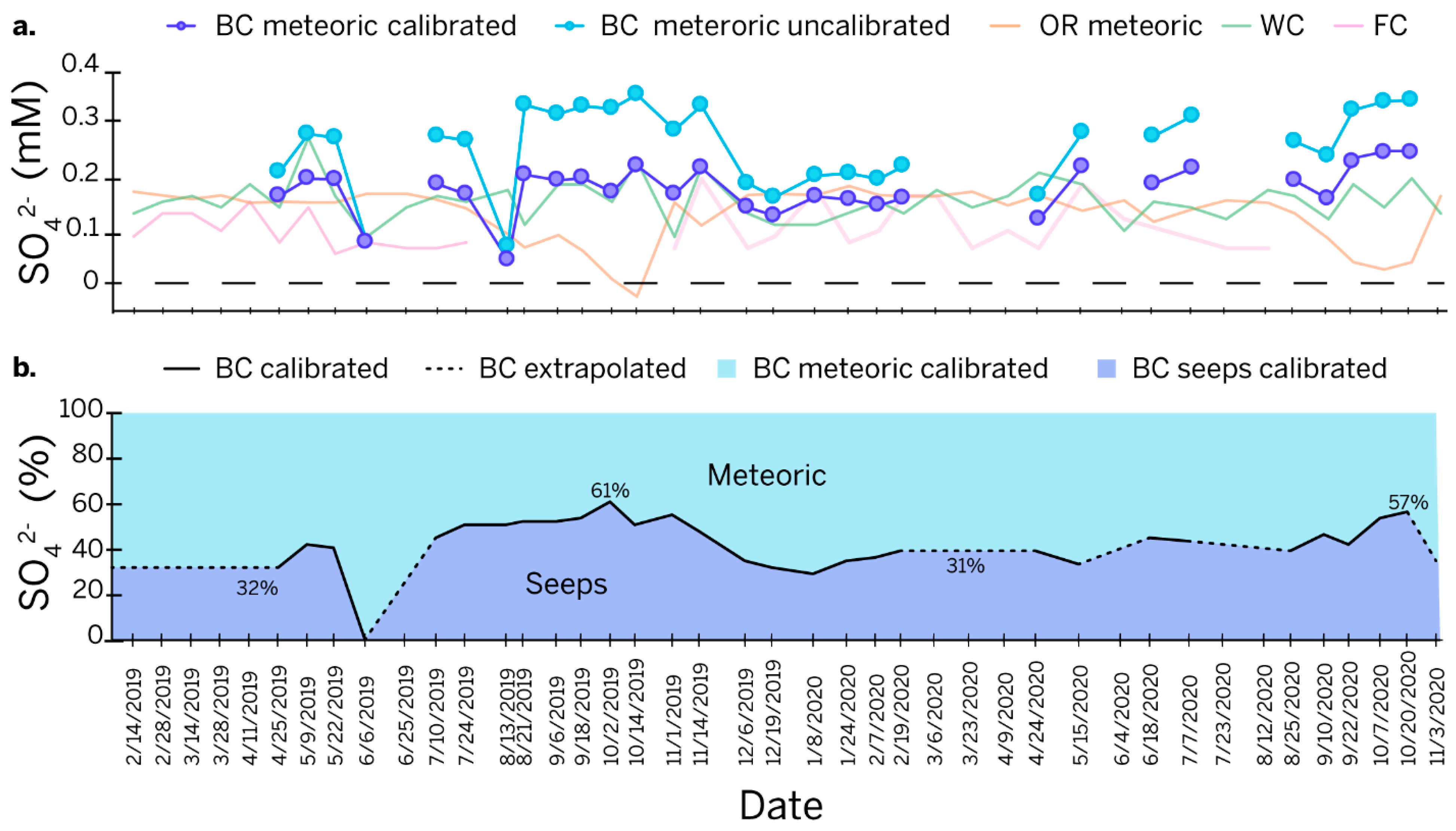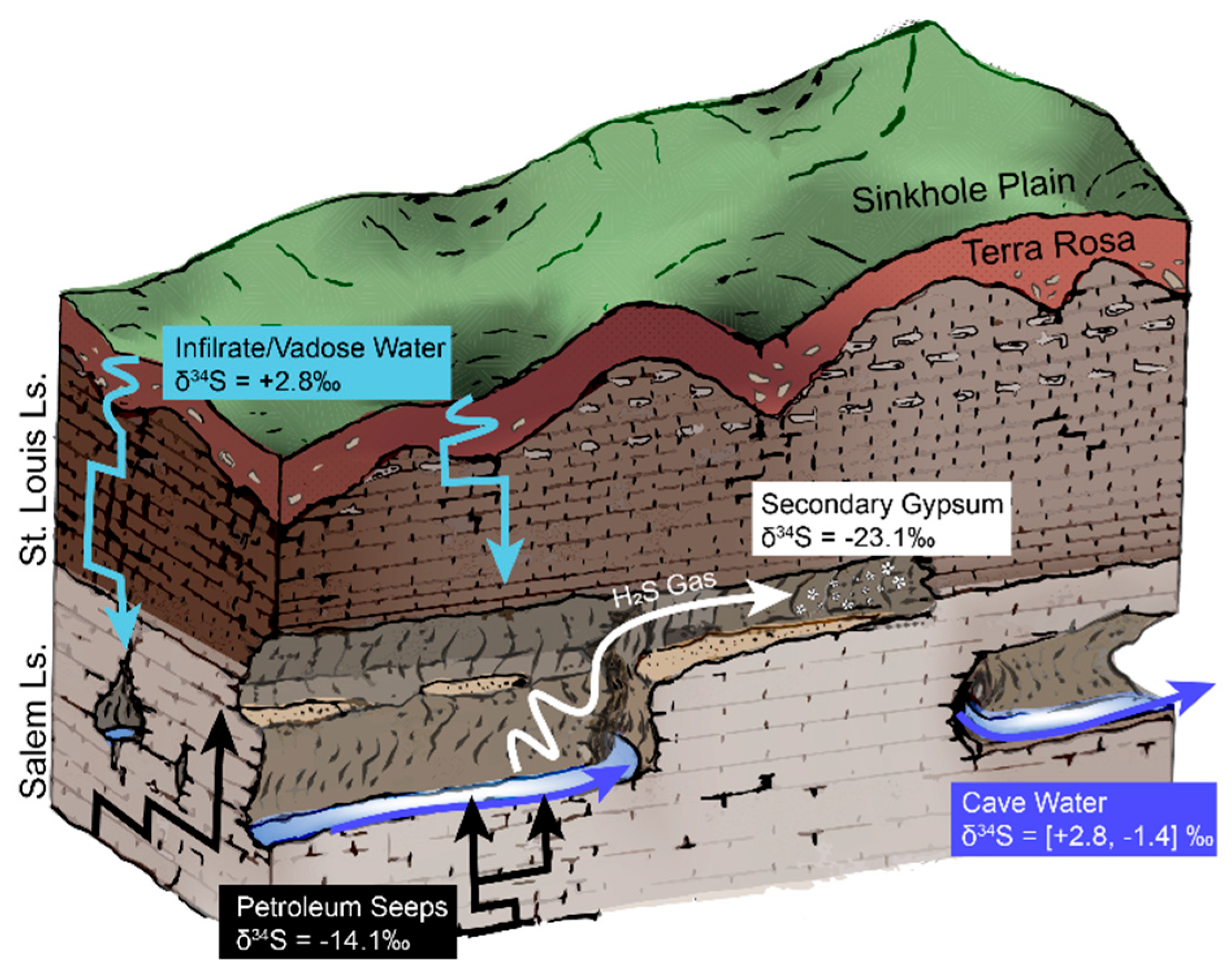Divergent Geochemical Pathways of Carbonate Aquifer Evolution in a Classic Karst Terrain: (1) Polygenetic Cave Development Identified Using Longitudinal Groundwater Geochemistry
Abstract
:1. Introduction
2. Site Characterization and Setting
3. Methods
3.1. Discrete Water Samples
3.2. Mixing Models
4. Results
4.1. Discrete Water Samples
4.2. Mixing Models
5. Discussion
5.1. Water Types in Mitchell Plateau Groundwater
5.2. Sulfur Systematics in the Mitchell Plateau
6. Conclusions
Supplementary Materials
Author Contributions
Funding
Data Availability Statement
Acknowledgments
Conflicts of Interest
References
- Curl, R.L. Speleology. Science 1962, 153, 559–560. [Google Scholar] [CrossRef]
- Shaw, T.R. History of Cave Science, the Exploration and Study of Limestone Caves, to 1900; Sydney Speleological Society: Broadway, NSW, Australia, 1992; p. 338. [Google Scholar]
- Vacher, H.; Florea, L.J. Quantitative hermeneutics: Counting forestructures on a path from W.M. Davis to the concept of multiple-permeability karst aquifers. Int. J. Speleol. 2015, 44, 207–230. [Google Scholar] [CrossRef]
- White, W.B. Geomorphology and Hydrology of Karst Terrains; No. 551.447 W4; University of South Florida: Tampa, FL, USA, 1988. [Google Scholar]
- Ford, D.; Williams, P. Karst Hydrogeology and Geomorphology; John Wiley & Sons: Hoboken, NJ, USA, 2007; p. 562. [Google Scholar]
- White, W. Chemistry and karst. Acta Carsol. 2015, 44, 349–362. [Google Scholar] [CrossRef]
- Klimchouk, A.; Palmer, A.N.; De Waele, J.; Auler, A.S.; Audra, P. (Eds.) Hypogene Karst Regions and Caves of the World; Springer: Berlin/Heidelberg, Germany, 2017. [Google Scholar]
- Krothe, N.C.; Libra, R.D. Sulfur isotopes and hydrochemical variations in spring waters of southern Indiana, U.S.A. J. Hydrol. 1983, 61, 267–283. [Google Scholar] [CrossRef]
- Lee, E.S.; Krothe, N.C. Delineating the karstic flow system in the upper Lost River drainage basin, south central Indiana: Using sulphate and δ34SSO4 as tracers. Appl. Geochem. 2003, 18, 145–153. [Google Scholar] [CrossRef]
- Florea, L.J. Carbon flux and landscape evolution in epigenic karst aquifers modeled from geochemical mass balance. Earth Surf. Process. Landf. 2015, 40, 1072–1087. [Google Scholar] [CrossRef]
- Barcelona, M.J.; Holm, T.R.; Schock, M.R.; George, G.K. Spatial and temporal gradients in aquifer oxidation-reduction conditions. Water Resour. Res. 1989, 25, 991–1003. [Google Scholar] [CrossRef]
- Sasowsky, I.; Palmer, M. (Eds.) Breakthroughs in Karst Geomicrobiology and Redox Geochemistry; Special Paper 1; Karst Waters Institute: Lewisburg, PA, USA, 1994. [Google Scholar]
- Davis, W.M. Origin of Limestone Caverns. Bull. Geol. Soc. Am. 1930, 41, 475–628. [Google Scholar] [CrossRef]
- Swinnerton, A.C. Origin of Limestone Caverns. Bull. Geol. Soc. Am. 1932, 43, 663–694. [Google Scholar] [CrossRef]
- Bretz, J.H. Bermuda: A partially drowned, late mature, pleistocene karst. Bull. Geol. Soc. Am. 1960, 71, 1729. [Google Scholar] [CrossRef]
- Ford, D.C.; Ewers, R.O. The development of limestone cave systems in the dimensions of length and depth. Can. J. Earth Sci. 1978, 15, 1783–1798. [Google Scholar] [CrossRef]
- Liu, Z.; Zhao, J. Contribution of carbonate rock weathering to the atmospheric CO2 sink. Environ. Geol. 2000, 39, 1053–1058. [Google Scholar] [CrossRef]
- Liu, Z.; Dreybrodt, W.; Wang, H. A new direction in effective accounting for the atmospheric CO2 budget: Considering the combined action of carbonate dissolution, the global water cycle and photosynthetic uptake of DIC by aquatic organisms. Earth-Sci. Rev. 2010, 99, 162–172. [Google Scholar] [CrossRef]
- Stets, E.G.; Striegl, R.G. Carbon export by rivers draining the conterminous United States. Inland Waters 2012, 2, 177–184. [Google Scholar] [CrossRef]
- Martin, J.B. Carbonate minerals in the global carbon cycle. Chem. Geol. 2017, 449, 58–72. [Google Scholar] [CrossRef]
- Zeng, S.; Liu, Z.; Kaufmann, G. Sensitivity of the global carbonate weathering carbon-sink flux to climate and land-use changes. Nat. Commun. 2019, 10, 5749. [Google Scholar] [CrossRef]
- Bai, X.; Zhang, S.; Li, C.; Xiong, L.; Song, F.; Du, C.; Li, M.; Luo, Q.; Xue, Y.; Wang, S. A carbon-neutrality-capactiy index for evaluating carbon sink contributions. Environ. Sci. Ecotechnol. 2023, 15, 100237. [Google Scholar] [CrossRef]
- Orr, J.C. Recent and Future Changes in Ocean Carbonate Chemistry. Ocean Acidif. 2011, 1, 41–66. [Google Scholar] [CrossRef]
- Torres, M.A.; West, A.J.; Li, G. Sulphide oxidation and carbonate dissolution as a source of CO2 over geological timescales. Nature 2014, 507, 346–349. [Google Scholar] [CrossRef]
- Li, C.; Smith, P.; Bai, X.; Tan, Q.; Luo, G.; Li, Q.; Wang, J.; Wu, L.; Chen, F.; Deng, Y.; et al. Effects of carbonate minerals and exogenous acids on carbon flux from the chemical weathering of granite and basalt. Glob. Planet. Change 2023, 221, 104053. [Google Scholar] [CrossRef]
- Klimchouk, A.; Ford, D. (Eds.) Hypogene Speleogenesis and Karst Hydrogeology of Artesian Basins; Special Paper; Ukrainian Institute of Speleology and Karstology: Simferopol, Ukraine, 2009; Volume 1, p. 292. [Google Scholar]
- Muyzer, G.; Stams, A.J.M. The ecology and biotechnology of sulphate-reducing bacteria. Nat. Rev. Genet. 2008, 6, 441–454. [Google Scholar] [CrossRef] [PubMed]
- Amrani, A. Organosulfur Compounds: Molecular and Isotopic Evolution from Biota to Oil and Gas. Annu. Rev. Earth Planet. Sci. 2014, 42, 733–768. [Google Scholar] [CrossRef]
- Jagnow, D.H.; Hill, C.A.; Davis, D.G.; DuChene, H.R.; Cunningham, K.I.; Northup, D.E.; Queen, J.M. History of the sulfuric acid theory of speleogenesis in the Guadalupe Mountains, New Mexico. J. Cave Karst Stud. 2000, 62, 54–59. [Google Scholar]
- Hill, C.A. Sulfuric Acid Speleogenesis of Carlsbad Cavern and Its Relationship to Hydrocarbons, Delaware Basin, New Mexico and Texas (1). AAPG Bull. 1990, 74, 1685–1694. [Google Scholar] [CrossRef]
- Hose, L.D.; Palmer, A.N.; Palmer, M.V.; Northup, D.E.; Boston, P.J.; DuChene, H.R. Microbiology and geochemistry in a hydrogen-sulphide-rich karst environment. Chem. Geol. 2000, 169, 399–423. [Google Scholar] [CrossRef]
- Galdenzi, S.; Menichetti, M. Occurrence of hypogenic caves in a karst region: Examples from central Italy. Environ. Geol. 1995, 26, 39–47. [Google Scholar] [CrossRef]
- Sarbu, S.M.; Kane, T.C.; Kinkle, B.K. A Chemoautotrophically Based Cave Ecosystem. Science 1996, 272, 1953–1955. [Google Scholar] [CrossRef]
- Onac, B.P.; Sumrall, J.; Tămaş, T.; Povară, I.; Kearns, J.; Dârmiceanu, V.; Veres, D.; Lascu, C. The Relationship Between Cave Minerals and H2S—Rich Thermal Waters along Cerna Valley (SW Romania). Acta Carsol. 2009, 38, 27–39. [Google Scholar] [CrossRef]
- Onac, B.P.; Wynn, J.G.; Sumrall, J.B. Tracing the sources of cave sulfates: A unique case from Cerna Valley, Romania. Chem. Geol. 2011, 288, 105–114. [Google Scholar] [CrossRef]
- Wynn, J.G.; Sumrall, J.B.; Onac, B.P. Sulfur isotopic composition and the source of dissolved sulfur species in thermo-mineral springs of the Cerna Valley, Romania. Chem. Geol. 2010, 271, 31–43. [Google Scholar] [CrossRef]
- Engel, A.S.; Stern, L.A.; Bennett, P.C. Microbial contributions to cave formation: New insights into sulfuric acid speleogenesis. Geology 2004, 32, 369. [Google Scholar] [CrossRef]
- Stafford, K.W.; Ulmer-Scholle, D.; Rosales-Lagarde, L. Hypogene calcitization: Evaporite diagenesis in the western Delaware Basin. Carbonates Evaporites 2008, 23, 89–103. [Google Scholar] [CrossRef]
- Polyak, V.J.; Asmerom, Y.; Hill, C.A.; Palmer, A.N.; Provencio, P.P.; Palmer, M.V.; McIntosh, W.C.; Decker, D.C.; Onac, B.P. Isotopic studies of byproducts of hypogene speleogenesis and their contribution to the geologic evolution of the western United States. Hypogene Cave Morphol. 2014, 18, 88–96. [Google Scholar]
- Palmer, A.N.; Palmer, M.V.; Paces, J.B.; Feinberg, J.; Gao, Y.; Alexander, E.C. Geologic history of the Black Hills caves, South Dakota. Caves Karst Across Time 2015, 516, 87–101. [Google Scholar] [CrossRef]
- Herman, J.S.; Lorah, M.M. CO2 outgassing and calcite precipitation in Falling Spring Creek, Virginia, USA. Chem. Geol. 1987, 62, 251–262. [Google Scholar] [CrossRef]
- Angert, E.R.; Northup, D.E.; Reysenbach, A.L.; Peek, A.S.; Goebel, B.M.; Pace, N.R. Molecular phylogenetic analysis of a bacterial community in Sulphur River, Parker Cave, Kentucky. Am. Mineral. 1989, 83, 1583–1592. [Google Scholar] [CrossRef]
- Florea, L.J. Sulfur-Based Speleogenesis in the Cumberland Plateau, USA. In Hypogene Karst Regions and Caves of the World; Springer: Cham, Switzerland, 2017; pp. 683–690. [Google Scholar] [CrossRef]
- Florea, L.J. Investigations into the potential for hypogene speleogenesis in the Cumberland Plateau of southeast Kentucky, USA. Acta Carsol. 2013, 42, 277–289. [Google Scholar]
- Florea, L.J.; Hasenmueller, N.R.; Branam, T.D.; Frushour, S.S.; Powell, R.L. Karst geology and hydrogeology of the Mitchell Plateau of south-central Indiana. In Ancient Oceans, Orogenic Uplifts, and Glacial Ice: Geologic Crossroads in America’s Heartland; Florea, L., Ed.; Geologic Society of America: Boulder, CO, USA, 2018. [Google Scholar] [CrossRef]
- Cannon, D.L. Delineating Mineral Water Flow Paths Using Oxygen, Hydrogen, and Inorganic Carbon Isotopes. Master’s Thesis, Department of Geological Sciences, Indiana University, Bloomington, IN, USA, 2002. [Google Scholar]
- Lakey, B.; Krothe, N.C. Stable Isotopic Variation of Storm Discharge from a Perennial Karst Spring, Indiana. Water Resour. Res. 1996, 32, 721–731. [Google Scholar] [CrossRef]
- Indiana Geological and Water Survey (IGWS). IndianaMap. Available online: https://maps.indiana.edu/ (accessed on 8 October 2021).
- Dawson, T.A. Deep Test Well in Lawrence County, Indiana: Drilling Techniques and Stratigraphic Interpretations; Indiana Geological & Water Survey: Bloomington, IN, USA, 1960. [Google Scholar]
- Keith, B.D.; Thompson, T.A. Rock cores in Monroe, Lawrence, and surrounding counties: Indiana Geological and Water Survey. Indiana J. Earth Sci. 2020, 2, 1–102. [Google Scholar]
- Bassett, J.L.; Ruhe, R.V. Geomorphology, Hydrology, and Soils in Karst. In Proceedings of the Southern Indiana Field Conference, Bloomington, IN, USA, 24–25 April 1974; Indiana University Water Resources Research Center: Bloomington, IN, USA, 1974; p. 54. [Google Scholar]
- Gray, H.H. The Mississippian and Pennsylvanian (Carboniferous) Systems in the United States—Indiana; U.S. Government Printing Office: Washington, DC, USA, 1979.
- Dawson, T.A.; Carpenter, G.L. Underground Storage of Natural Gas in Indiana; Indiana Geological & Water Survey: Bloomington, IN, USA, 1963; p. 28. [Google Scholar]
- Melhorn, W.N.; Smith, N.M. The Mt. Carmel Fault and Related Structural Features in South-Central Indiana; Indiana Geological Survey Report of Progress 16; Indiana Geological & Water Survey: Bloomington, IN, USA, 1959. [Google Scholar]
- Erd, R.C.; Evans, H.T.; Richter, D.H. Smythite, a new iron sulfide, and associated pyrrhotite from Indiana. Am. Mineral. J. Earth Planet. Mater. 1957, 42, 309–333. [Google Scholar]
- Heyl, A.V. Minor epigenetic, diagenetic, and syngenetic sulfide, fluorite, and barite occurrences in the central United States. Econ. Geol. 1968, 63, 585–594. [Google Scholar] [CrossRef]
- Peel, M.C.; Finlayson, B.L.; McMahon, T.A. Updated world map of the Köppen-Geiger climate classification. Hydrol. Earth Syst. Sci. 2007, 11, 1633–1644. [Google Scholar] [CrossRef]
- Vose, R.S.; Applequist, S.; Squires, M.; Durre, I.; Menne, M.J.; Williams, C.N., Jr.; Fenimore, C.; Gleason, K.; Arndt, D. NOAA Monthly U.S. Climate Divisional Database (NClimDiv); Climate Division IN08; NOAA National Climatic Data Center: Asheville, NC, USA, 2014. [CrossRef]
- Palmer, A.N. Origin and morphology of limestone caves. Geol. Soc. Am. Bull. 1991, 103, 1–21. [Google Scholar] [CrossRef]
- NOAA National Centers for Environmental Information. Integrated Surface Dataset; NOAA National Centers for Environmental Information: Asheville, NC, USA, 2001.
- Wilde, F.D. Water-Quality Sampling by the U.S. Geological Survey: Standard Protocols and Procedures; US Geological Survey Fact Sheet; U.S. Geological Survey: Reston, VA, USA, 2010. [CrossRef]
- Furtak, H.; Langguth, H.R. Zur Hydrochemischen Kennzeichnung von Grundwässern und Grund-Wassertypen Mittels Kennzahlen, Mem; IAH-Congress: Hannover, Germany, 1967; pp. 86–96. [Google Scholar]
- Piper, A.M. A graphic procedure in the geochemical interpretation of water-analyses. Eos Trans. Am. Geophys. Union 1944, 25, 914–928. [Google Scholar] [CrossRef]
- Winston, R.B. GW_Chart, Version 1.30; U.S. Geological Survey Software Release: Bloomington, IN, USA, 26 June 2020. [CrossRef]
- Jørgensen, B.B.; Findlay, A.J.; Pellerin, A. The Biogeochemical Sulfur Cycle of Marine Sediments. Front. Microbiol. 2019, 10, 849. [Google Scholar] [CrossRef]
- Bassett, J. Hydrology and geochemistry of the upper Lost River drainage basin, Indiana. NSS Bull. 1976, 38, 79–87. [Google Scholar]
- Palmer, A.N. The Survey of Blue Spring Cave, Lawrence Co., Indiana. In Proceedings of the Indiana Academy of Science; Indiana University: Bloomington, IN, USA, 1967; Volume 77, pp. 245–249. [Google Scholar]
- Palmer, A.N. Distinction between epigenic and hypogenic maze caves. Geomorphology 2011, 134, 9–22. [Google Scholar] [CrossRef]








| Sample Name | Core ID | Depth from Top of St. Louis (m) | Composition | Dissolved SO42× | Evaporites Dissolved % | δ34S | ||
|---|---|---|---|---|---|---|---|---|
| Gypsum % | Anhydrite % | Expected (mg/L) | Actual (mg/L) | ‰ | ||||
| RF65-45 | SDH114 | 16.5 | 13.8 | 43.0 | 762 | 660 | 73.4 | 14.68 |
| RF65-47 | SDH114 | 18.9 | 5.4 | 3.5 | 110 | 112 | 12.9 | 14.50 |
| RF65-57 | SDH114 | 26.8 | 13.1 | 62.5 | 1029 | 1175 | 79.0 | 16.16 |
| RF65-60 | SDH114 | 27.4 | 4.1 | 12.0 | 215 | 280 | 20.7 | 16.03 |
| DC69-294 | SDH190 | 53.9 | 20.6 | 70.4 | 1223 | 1350 | 84.7 | 16.54 |
| DC69-298 | SDH190 | 57.0 | 20.7 | 66.1 | 1164 | 1350 | 89.0 | 17.08 |
| DC69-299 | SDH190 | 58.2 | 16.9 | 21.6 | 494 | 600 | 46.2 | 16.68 |
| DC69-311 | SDH190 | 67.3 | 75.7 | 15.4 | 1063 | 1120 | 81.6 | 17.91 |
| Site | Sample Name | Date | Stable Isotopes | ||
|---|---|---|---|---|---|
| δ13CDIC | δ34SSO4 | δ34SH2S | |||
| ‰ | ‰ | ‰ | |||
| Bluespring Caverns | SB200307A | 7 March 2020 | - | −22.90 | - |
| Bluespring Caverns | SB200307B | 7 March 2020 | - | −23.30 | - |
| Bluespring Caverns | SB200307C | 7 March 2020 | −6.30 | - | - |
| Bluespring Caverns | SB200306A | 6 March 2020 | −14.50 | - | - |
| Bluespring Caverns | SB210121A | 21 January 2021 | −5.44 | −3.40 | −14.1 |
| Bluespring Caverns | SB210121B | 21 January 2021 | −12.67 | 0.00 | - |
Disclaimer/Publisher’s Note: The statements, opinions and data contained in all publications are solely those of the individual author(s) and contributor(s) and not of MDPI and/or the editor(s). MDPI and/or the editor(s) disclaim responsibility for any injury to people or property resulting from any ideas, methods, instructions or products referred to in the content. |
© 2023 by the authors. Licensee MDPI, Basel, Switzerland. This article is an open access article distributed under the terms and conditions of the Creative Commons Attribution (CC BY) license (https://creativecommons.org/licenses/by/4.0/).
Share and Cite
Burgess, S.A.; Florea, L.J.; Branam, T.D. Divergent Geochemical Pathways of Carbonate Aquifer Evolution in a Classic Karst Terrain: (1) Polygenetic Cave Development Identified Using Longitudinal Groundwater Geochemistry. Water 2023, 15, 3410. https://doi.org/10.3390/w15193410
Burgess SA, Florea LJ, Branam TD. Divergent Geochemical Pathways of Carbonate Aquifer Evolution in a Classic Karst Terrain: (1) Polygenetic Cave Development Identified Using Longitudinal Groundwater Geochemistry. Water. 2023; 15(19):3410. https://doi.org/10.3390/w15193410
Chicago/Turabian StyleBurgess, Sarah A., Lee J. Florea, and Tracy D. Branam. 2023. "Divergent Geochemical Pathways of Carbonate Aquifer Evolution in a Classic Karst Terrain: (1) Polygenetic Cave Development Identified Using Longitudinal Groundwater Geochemistry" Water 15, no. 19: 3410. https://doi.org/10.3390/w15193410
APA StyleBurgess, S. A., Florea, L. J., & Branam, T. D. (2023). Divergent Geochemical Pathways of Carbonate Aquifer Evolution in a Classic Karst Terrain: (1) Polygenetic Cave Development Identified Using Longitudinal Groundwater Geochemistry. Water, 15(19), 3410. https://doi.org/10.3390/w15193410







